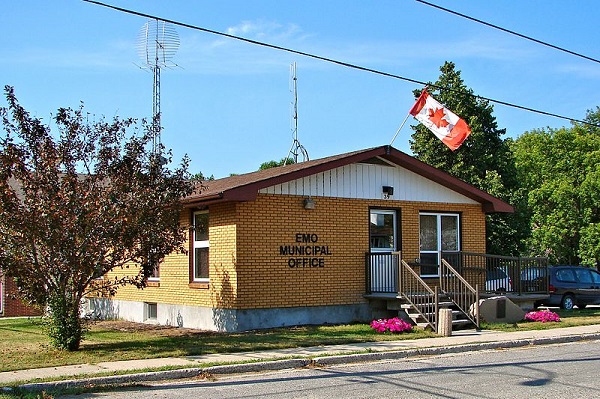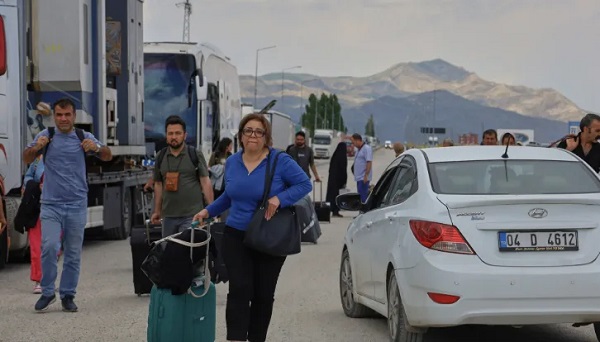National
Canadian town appeals ruling that forces them to pay LGBT group over ‘pride’ flag dispute

From LifeSiteNews
The irony of the ruling is that Emo’s town hall doesn’t even have a flagpole
A Canadian town has announced it will seek a “judicial review” regarding a decision that saw it being mandated by a tribunal to pay an LGBT group thousands of dollars because it refused to cave to activists’ demands by declaring June “Pride Month” and flying the related rainbow flag.
In a media statement Thursday, the town of Emo, Ontario, said it has “decided to seek judicial review of the decision of the Human Rights Tribunal of Ontario. As the matter is proceeding to the Divisional Court, we will not be commenting further at this time.”
The town noted that it wished “to state that it made a Declaration of Equality in 2022, which remains in effect today.”
“The Township recognizes the dignity and worth of all people, as well as the barriers of discrimination and disadvantage faced by human rights protected groups, including members of the LGBTQ2+ community,” said the town in its 2022 declaration.

As reported by LifeSiteNews, last month Mayor Harold McQuaker of Emo, Ontario, was ordered by an Ontario Human Rights Tribunal to pay local LGBT activist group Borderland Pride $5,000 for refusing to celebrate the LGBT agenda during the month of June. The town was also ordered to pay $10,000.
Specifically, the mayor and town had refused to cave to demands to fly the LGBT “Pride flag” and declare the month of June to be “Pride Month.”
After the mayor refused to pay, his bank account appears to have been garnished to pay for damages ordered against him by the tribunal.
McQuaker had publicly protested the tribunal’s orders, calling them a form of “extortion.” In a vulgar Facebook post, Borderland Pride claimed they were successful in forcing money from the mayor via the garnishing of his bank funds.
“Sure, sex is great, but have you ever garnished your mayor’s bank account after he publicly refused to comply with a Tribunal’s order to pay damages?” wrote the group on Facebook.
McQuaker previously had told the Toronto Sun, “I utterly refuse to pay the $5,000 because that’s extortion” and said he would not undergo the Ontario Human Rights Commission re-education course.
Ontario adjudicator Karen Dawson wrote in her decision against McQuaker that “$15,000 is an appropriate level of compensation for Borderland Pride’s injury to dignity, feelings and self-respect.”
The irony of the ruling is that Emo’s town hall doesn’t even have a flagpole.
Emo is not the only town in Canada that has recently banned the flying of “Pride” flags from municipal buildings.
As reported by LifeSiteNews, residents of the Canadian town of Barrhead, Alberta, recently voted in a solid majority to pass a bylaw that will in effect ban pro-LGBT “Pride” themed designs from being displayed on public infrastructure, including such flags on government buildings and rainbow painted crosswalks.
Residents in the Alberta town of Westlock likewise passed a bylaw that bans all non-governmental flags from municipal buildings and mandates that crosswalks only be painted in the standard white-striped pattern.
The LGBT indoctrination in Canadian cities and towns via “Pride month,” which often includes flags and painted crosswalks, has been described by LifeSiteNews columnist Jonathon Van Maren as “not a ‘celebration of Pride,’” but as “an assertion of ownership, a declaration of dominance” over “public spaces.”
Van Maren recently observed celebrated the Emo mayor, writing, “Harold McQuaker isn’t having any of it (LGBT activists demands). And we need more like him.”
Business
Canada’s critical minerals are key to negotiating with Trump

From Resource Works
The United States wants to break its reliance on China for minerals, giving Canada a distinct advantage.
Trade issues were top of mind when United States President Donald Trump landed in Kananaskis, Alberta, for the G7 Summit. As he was met by Prime Minister Mark Carney, Canada’s vast supply of critical minerals loomed large over a potential trade deal between North America’s two largest countries.
Although Trump’s appearance at the G7 Summit was cut short by the outbreak of open hostilities between Iran and Israel, the occasion still marked a turning point in commercial and economic relations between Canada and the U.S. Whether they worsen or improve remains to be seen, but given Trump’s strategy of breaking American dependence on China for critical minerals, Canada is in a favourable position.
Despite the president’s early exit, he and Prime Minister Carney signed an accord that pledged to strike a Canada-US trade deal within 30 days.
Canada’s minerals are a natural advantage during trade talks due to the rise in worldwide demand for them. Without the minerals that Canada can produce and export, it is impossible to power modern industries like defence, renewable energy, and electric vehicles (EV).
Nickel, gallium, germanium, cobalt, graphite, and tungsten can all be found in Canada, and the U.S. will need them to maintain its leadership in the fields of technology and economics.
The fallout from Trump’s tough talk on tariff policy and his musings about annexing Canada have only increased the importance of mineral security. The president’s plan extends beyond the economy and is vital for his strategy of protecting American geopolitical interests.
Currently, the U.S. remains dependent on China for rare earth minerals, and this is a major handicap due to their rivalry with Beijing. Canada has been named as a key partner and ally in addressing that strategic gap.
Canada currently holds 34 critical minerals, offering a crucial potential advantage to the U.S. and a strategic alternative to the near-monopoly currently held by the Chinese. The Ring of Fire, a vast region of northern Ontario, is a treasure trove of critical minerals and has long been discussed as a future powerhouse of Canadian mining.
Ontario’s provincial government is spearheading the region’s development and is moving fast with legislation intended to speed up and streamline that process. In Ottawa, there is agreement between the Liberal government and Conservative opposition that the Ring of Fire needs to be developed to bolster the Canadian economy and national trade strategies.
Whether Canada comes away from the negotiations with the US in a stronger or weaker place will depend on the federal government’s willingness to make hard choices. One of those will be ramping up development, which can just as easily excite local communities as it can upset them.
One of the great drags on the Canadian economy over the past decade has been the inability to finish projects in a timely manner, especially in the natural resource sector. There was no good reason for the Trans Mountain pipeline expansion to take over a decade to complete, and for new mines to still take nearly twice that amount of time to be completed.
Canada is already an energy powerhouse and can very easily turn itself into a superpower in that sector. With that should come the ambition to unlock our mineral potential to complement that. Whether it be energy, water, uranium, or minerals, Canada has everything it needs to become the democratic world’s supplier of choice in the modern economy.
Given that world trade is in flux and its future is uncertain, it is better for Canada to enter that future from a place of strength, not weakness. There is no other choice.
Economy
Ottawa’s muddy energy policy leaves more questions than answers

From the Fraser Institute
Based on the recent throne speech (delivered by a King, no less) and subsequent periodic statements from Prime Minister Carney, the new federal government seems stuck in an ambiguous and ill-defined state of energy policy, leaving much open to question.
After meeting with the premiers earlier this month, the prime minister talked about “decarbonized barrels” of oil, which didn’t clarify matters much. We also have a stated goal of making Canada the world’s “leading energy superpower” in both clean and conventional energy. If “conventional energy” includes oil and gas (although we’re not sure), this could represent a reversal of the Trudeau government’s plan to phase-out fossil fuel use in Canada over the next few decades. Of course, if it only refers to hydro and nuclear (also forms of conventional energy) it might not.
According to the throne speech, the Carney government will work “closely with provinces, territories, and Indigenous Peoples to identify and catalyse projects of national significance. Projects that will connect Canada, that will deepen Canada’s ties with the world, and that will create high-paying jobs for generations.” That could mean more oil and gas pipelines, but then again, it might not—it might only refer to power transmission infrastructure for wind and solar power. Again, the government hasn’t been specific.
The throne speech was a bit more specific on the topic of regulatory reform and the federal impact assessment process for energy projects. Per the speech, a new “Major Federal Project Office” will ensure the time needed to approve projects will be reduced from the currently statutory limit of five years to two. Also, the government will strike cooperation agreements with interested provinces and territories within six months to establish a review standard of “one project, one review.” All of this, of course, is to take place while “upholding Canada’s world-leading environmental standards and its constitutional obligations to Indigenous Peoples.” However, what types of projects are likely to be approved is not discussed. Could be oil and gas, could be only wind and solar.
Potentially good stuff, but ill-defined, and without reference to the hard roadblocks the Trudeau government erected over the last decade that might thwart this vision.
For example, in 2019 the Trudeau government enacted Bill C-48 (a.k.a. the “Tanker Ban Bill”), which changed regulations for large oil transports coming and going from ports on British Columbia’s northern coast, effectively banning such shipments and limiting the ability of Canadian firms to export to non-U.S. markets. Scrapping C-48 would remove one obstacle from the government’s agenda.
In 2023, the Trudeau government introduced a cap on Canadian oil and gas-related greenhouse gas emissions, and in 2024, adopted major new regulations for methane emissions in the oil and gas sector, which will almost inevitably raise costs and curtail production. Removing these regulatory burdens from Canada’s energy sector would also help Canada achieve energy superpower status.
Finally, in 2024, the Trudeau government instituted new electricity regulations that will likely drive electricity rates through the roof, while ushering in an age of less-reliable electricity supply: a two-handed slap to Canadian energy consumers. Remember, the throne speech also called for building a more “affordable” Canada—eliminating these onerous regulations would help.
In summation, while the waters remain somewhat muddy, the Carney government appears to have some good ideas for Canadian energy policy. But it must act and enact some hard legislative and regulatory reforms to realize the positive promises of good policy.
-

 Business2 days ago
Business2 days agoThe CBC is a government-funded giant no one watches
-

 conflict2 days ago
conflict2 days agoMiddle East clash sends oil prices soaring
-

 Business2 days ago
Business2 days agoTrump makes impact on G7 before he makes his exit
-

 Alberta2 days ago
Alberta2 days agoAlberta is investing up to $50 million into new technologies to help reduce oil sands mine water
-

 Also Interesting2 days ago
Also Interesting2 days agoHow to Use Bonuses at Magius Casino and Similar Websites
-

 conflict2 days ago
conflict2 days agoTrump Threatens Strike on Khamenei as Israel Pounds Iranian Military Command
-

 conflict2 days ago
conflict2 days agoTrump: ‘We’ have control over Iranian airspace; know where Khomeini is hiding
-

 Alberta1 day ago
Alberta1 day agoAlberta health care blockbuster: Province eliminating AHS Health Zones in favour of local decision-making!






